#national trust for historic preservation
Text
#museums#private museums#art#private vs public#private foundations#national trust for historic preservation#IRS#tax deductions
11 notes
·
View notes
Text
"She knows my job as well as hers."
Indiana Landmarks' Friday Links page highlights Minerva Parker Nichols, architect, the first woman to have her own solo private office.

The Rachel Foster Avery house, designed by Nichols; photo: Elizabeth Felicella.
From the National Trust for Historic Preservation, Jared Foretek writes "Even for architecture buffs, her legacy remains somewhat obscure...[she] was a pioneer in her field, not only because she was the first woman in the country to have her own independent practice, but also for the path she took to get there."
Nichols studied the building trades as well as architecture, and her knowledge of how structures were built led to that opening quote, which could be attributed to any number of the foremen she worked with.
According to researcher Molly Lester, whose interest began with Nichols as a thesis topic:
“There just weren’t opportunities for women to network and get the clients that would sustain a practice...So I think she really bridged those worlds well. That’s not to say she never experienced resistance, but she just claimed a place not based on the fact that she was a woman, but because she knew she was well trained.”

wikimedia commons: American Women: Fifteen Hundred Biographies with Over 1,400 Portraits, Frances E. Willard and Mary A. Livermore, editors.
Lester has also dedicated a website to preserving the story and legacy of Nichols, featuring the work of several like-minded researchers and historians, all endeavoring to bring Nichols back into the historical record.
The site encompasses Nichols' biography and portfolio (including photos of many of the still extant houses), plus links to Lester's podcast and other relevant media.
Nichols' work, Lester relates, was seen as "striking, yet delicate, homelike, and very harmonious," and notes that she "...earned nearly universal praise from contemporary trade publications."
Full story from the National Trust for Historic Preservation
Minerva Parker Nichols website
#History!#Minerva Parker Nichols#women architects#architecture#indiana landmarks#national trust for historic preservation
0 notes
Text
There is a forest outside my back door. This Frank Lloyd Wright Usonian House is just around the corner through the woods.
1 note
·
View note
Text
Gebreyonhanes to the rescue!
Gebreyonhanes to the rescue!
Restore Trust’s Zewditu Gebreyonhanes discusses the National Trust’s policies with Peter Whittle for New Culture Forum. (Restore Trust)
In Britain, a new organization has arisen to push back against the backsliding of an old organization. Restore Trust believes that the National Trust’s mission of preserving the nation’s most treasured historic buildings has been downgraded in favor of allegedly…

View On WordPress
#Conservation#Great Britain#King Charles III#National Trust#National Trust for Historic Preservation#Restore Trust#Roger Scruton#Zewditu Gebreyonhanes
0 notes
Text
Uffington White Horse: A Personal Journey Through Time and Chalk
This striking figure of a horse etched onto a hillside in Oxfordshire, made of trenches filled with white chalk, it stretches across the hill, both grand and unassuming against the backdrop of nature's green,
I came across something fascinating in the news today, and it made me pause and reflect. Have you ever heard of the Uffington White Horse? It’s this striking figure of a horse etched onto a hillside in Oxfordshire, made of trenches filled with white chalk, it stretches across the hill, both grand and unassuming against the backdrop of nature’s green, a silent witness to…
Pic: © Copyright Dave Price

View On WordPress
#facelift#Historic#M4#National Trust#Oxfordshire#Post a day#Postaday#preserve#Re-chalking#Swindon#Travel#Uffington#Uffington White Horse#Whitehorse Hill
0 notes
Text
Some historical context for Olrox

Okay, let me prephase this with one important message: Castlevania Nocturne made me really happy by making the plot all about colonialism, as colonialism and its fallout and how it influences us to this day is a topic that I am very passionate about. We do not talk enough about it. The US does not talk enough about it because it could make white people feel uncomfortable. And here in Germany we do not talk about it, because we act as if this had nothing to do with us at all.
But the show talks about it and I love it.
And I honestly also gotta say that I love that the BI_PoC character have a concrete cultural heritage. Olrox is Aztec, Annette is Yoruba, and Drolta is Egyptian. Other shows: Please take notes!
But let's talk Olrox, because he is so fucking interesting and amazing!
We know about him that he is Aztec and also that he is 250 years old. Or roughly that old by the time he kills Julia. Which would put either his birth or his turning somewhere around 1530.
Now, the fall of the Aztec Empire has a very exact date: August 13th, 1521. But you should keep in mind that this does not mean that on that day the Aztec's are extinct. To this day there is still 1,5 million people speaking Nahuatl, the language of the Aztecs, and preserving some of the Aztec cultural traditions. It was just that on that day the empire construct fell to Cortez and the Spaniad conquistadors and a lot of Aztecs went into exile to flee the genocide that Cortez was bringing upon them.
The question of course is: Was Olrox still human at this time or was he already a vampire? From his dialogue it is clear that he was at least alive and grown enough to remember the fall of the empire and the distruction Cortez and his men brought upon them. But you can bet it was very traumatic.
I also am assuming he was turned by a white man. Because so far my assumption is that vampirism is an old world thing that got brought to the new world through colonialism. (Mostly because in Dracula's court we do not see any new world vampires.)

Now, the other interesting thing is what he says about his dead lover. The one Julia killed. So, first the "town in Massachusetts" he speaks about is clearly Stockbridge. Which was the town in which many Mohicans have settled during the colonial times, as well as other people from the Iroquois Nations. Now, it should be noted that the Mohicans were not part of the Iroquois alliance and in fact went to war with the Iroquois, but by the time colonialism really geared up there was some cooperation between the Mohicans and Iroquois.
Due to this they were in an alliance with the Oneida (who were part of the Iroquois) by the time of the Revolutionary war. Now, the Revolutionary War created a lot of conflict between the Iroquois nations, because they did not agree which side they should fight on. Of course both sides promised that they could keep their land, but the Mohawk, Onondaga, Cayuga, and Seneca did not trust the colonists and hence sided with the British, while the Oneida and Tuscarora (and through them also the Mohicans) sided with the Colonists.
And the dead lover clearly was among those siding with the colonists. Now, a quick refresher for the non-Americans (and the Americans who slept to history class, which is understandable). The Revolutionary War lasted from April 19, 1775 to September 3, 1783 (which, yes, also means that Julia and Richter probably were in the US during the war the entire time and the "evil" Julia was fighting probably was linked to it). And of course we all know how it ended for the Indigenous people: The colonists won, countless Indigenous folks died on both sides, only to get booted of their land soon after. The Oneida und Mohicans were made to move westwards not soon after the war ended. So, yes, Olrox would have seen that happen.

Now, an interesting thing in his dialogue was when Erzebet said: "We will create a new world." To which he replies: "I have heard that one before." And she says: "This time we are going to make it to last."
And the big question is to what this is refering. Is it refering to the colonialization or is it refering to the revolutionary war? Or something entirely different. In both cases it would be possible. And yes, the American Revolution definitely were claiming to create a new world. But was it that what he refered to or something else?
Well, never the less: Interesting character. Really good writing.
#castlevania#castlevania nocturne#castlevania netflix#castlevania nocturne spoilers#castlevania olrox#american history#history#colonialism#colonial history#aztec
4K notes
·
View notes
Note
Any chance you know of some good archaeology/history youtube channels? Everytime i try searching i just get aliens and atlantis garbage
First and foremost in my heart will always be Time Team. This is a tv program that does three day digs in the UK, and it has some of the most realistic archaeology I've yet to find on tv. You can watch old episodes for free on their official YouTube channel (linked above)
I personally enjoy the historical programing done by the American Battlefield Trust. It's very Civil War-centric, and it does fall into the very politically-middle-of-the-road category that a lot of military organizations do, but they're good for what they are.
Tasting history is pretty much exactly what it sounds like! Think B Dylan Hollis, but maybe less sass and cooking as well as baking.
Karolina Żebrowska is one of the best and funniest historical fashion YouTubers I've yet to come across. Iconic, truly.
Janet Stephens does EXPERIMENTAL HAIR ARCHAEOLOGY! Basically, she finds out how to accurately recreate incredibly complex hairstyles from the past based on art. She's awesome.
Modern History TV is my go to for all things Medieval. He does a great job demonstrating the ins and outs of everyday Medieval life.
Enjoy,
-Reid
511 notes
·
View notes
Text
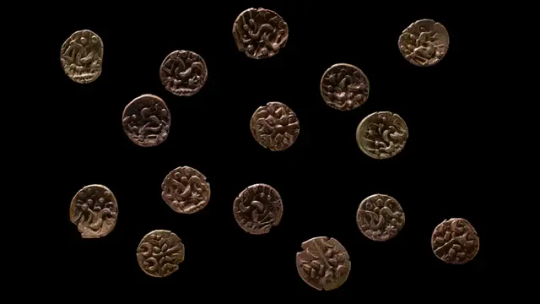
A 2,000-Year-old Iron Age Gold Treasure Found in Wales
Gold coins dating back more than 2,000 years have been found by metal detectorists in Wales, making them the first hoard of Iron Age gold coins to have been discovered in the country.
The 15 coins, which have been declared treasure, are known as staters. They were found the Welsh island of Anglesey, off the northwest coast of the country’s mainland.
Struck between 60 BC and 20 BC, the coins belonged to the Corieltavi tribe, who at the time inhabited the geographical area that is now England’s East Midlands, according to a National Museum Wales press release.
The precious metals were unearthed by three metal detectorists in a field between July 2021 and March 2022.
Lloyd Roberts, who said he has been a metal detectorist for more than 14 years, found the first coin.
“Finding a gold stater was always number one on my wish list,” he said in the release, adding: “That one coin alone would have made my year, but I went on to find another on my next signal.”
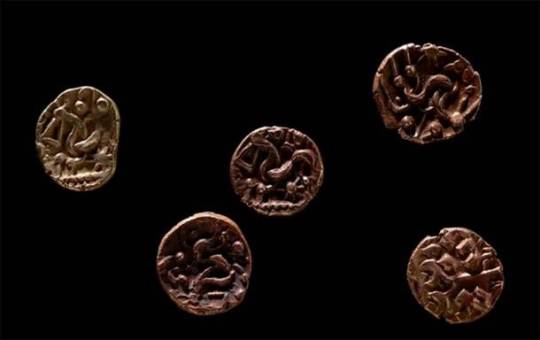
Roberts said that his friend, Peter Cockton, found the next three. They then contacted the Portable Antiquities Scheme, an organization which records such historical and archaeological finds.
Tim Watson, who said he only began metal detecting following encouragement from his father during lockdown, found the sixth.
“I rushed home to show my wife and we were both in awe of this coin, which was like nothing else I had found, immaculately preserved with such unusual stylised images,” Watson said in the release.
Watson said his enthusiasm led him to upgrade his metal detector and he found the remaining nine coins in the following weeks.
‘Rich archaeological landscape’
The gold coins’ elaborate design derives from those of Philip II, who ruled the ancient kingdom of Macedonia from 359 BC to 336 BC. The heads side of the coins shows the mythological deity Apollo’s wreath and hair, while the tails side shows a triangular-headed horse surrounded by symbols.
The coins were likely not used for everyday transactions, except potentially for some high-value purchases, according to the release. Instead, the staters are thought to have been used as gifts between the elites to secure alliances or show loyalty.
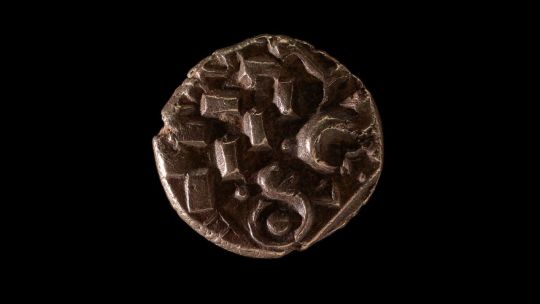
Another option is that the Corieltavi tribe used them to form part of an exchange for copper, which there were sources of in various parts of the island.
The staters could also have been used as “offerings to the gods” to fulfill a vow, according to National Museum Wales. Other archaeological finds from Anglesey, as well as Roman sources referring to the island that feature pagan priests, suggest the area was an important religious center at the time.
Gwynedd Archaeological Trust visited the site in September 2021 to see if there were any clues as to why the coins were buried there.
“This hoard is a fantastic example of the rich archaeological landscape that exists in North-West Wales,” said Sean Derby, Historic Environment Record archaeologist at Gwynedd Archaeological Trust. “While the immediate vicinity of the find did not yield any clues as to the find’s origin, the findspot lies in an area of known prehistoric and early Roman activity and helps increase our understanding of this region.”
Welsh museum Oriel Môn is looking to acquire the coins and put them on public display.
By Amarachi Orie.


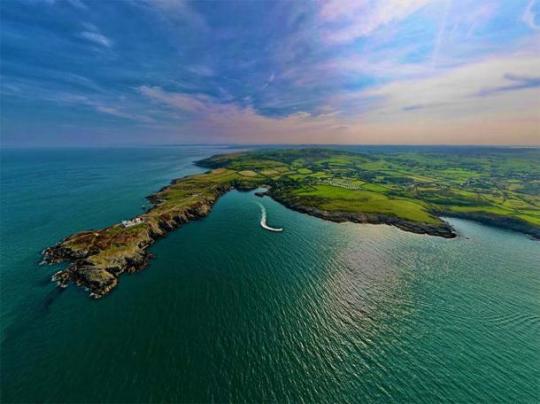
#A 2000-Year-old Iron Age Gold Treasure Found in Wales#gold#gold coins#collectable coins#treasure#metal detecting#ancient artifacts#archeology#archeolgst#history#history news#ancient history#ancient culture#ancient civilizations#the Corieltavi tribe
162 notes
·
View notes
Text
A new discovery has been made in Thunder Bay National Marine Sanctuary!
Researchers from NOAA, the state of Michigan, and Ocean Exploration Trust have discovered an intact shipwreck resting hundreds of feet below the surface of Lake Huron. The shipwreck has been identified as the sailing ship Ironton. Magnificently preserved by the cold freshwater of the Great Lakes for over a century, the 191-foot Ironton rests upright with its three masts still standing.
Learn more about this exciting discovery:
Learn more about Thunder Bay National Marine Sanctuary:
#EarthIsBlue#ThunderBay#Shipwreck#Ironton#Discovery#Michigan#LakeHuron#Science#History#Wreck#Research
245 notes
·
View notes
Text
https://www.theguardian.com/us-news/2022/may/27/bison-range-native-tribes-reclaim-montana-nature-preserve
Members of the Confederated Salish and Kootenai tribes (CSKT) and neighbors gathered under a large tent to sing and dance in celebration of a historic event: the tribes’ reclamation of management of the bison range after more than a century of federal management and nearly two decades of negotiations.
“This all dates back to the treaty of 1855, when that agreement wasn’t honored and this land was taken by the government,” said Stephanie Gillin, wildlife biologist for the CSKT Natural Resources Department.
CSKT tribal chairman Tom McDonald said the restoration of the bison range to tribal control is about more than just land. By righting a longstanding wrong, he said, the transfer helps foster trust and encourages collaboration between tribal nations and government agencies, restoring honor to once-broken treaties and allowing tribes to steward the land as they had for thousands of years.
“It’s a restoration of a piece that was missing. It represents a gift of what we may care for to protect and have something for future generations,” McDonald said. The three-day celebration began with a powwow on Friday and ended with half-price entry to the range on Sunday. The event featured appearances by Montana senator Jon Tester and Secretary of the Interior Deb Haaland.
On Saturday, Haaland spoke before a crowd at Salish Kootenai College in Pablo to honor the resilience of tribal nations.
“With the loss of tribal homelands and the depletion of the buffalo herds, the plains tribes lost traditional connections with this beautiful animal. But despite that terrible tragedy and loss, we are still here. You are still here. And that is something to celebrate,” Haaland said.
After years of failed negotiations, the transfer was accomplished through enactment of the Montana Water Rights Protection Act of 2020, returning the bison range to CSKT management. The transfer became official on 2 January 2022.
“The return of the bison range to these tribes is a triumph and a testament to what can happen when we collaboratively work together to restore balance to ecosystems that were injured by greed and disrespect,” Haaland said.
From heartfelt speeches to rambunctious Native games, the event was full of life, joy and color. On Friday, an announcer repeatedly proclaimed, “It’s a good day to be Indian.”
Every elder who spoke reiterated the important role played by bison in Native culture, including a deep spiritual connection that makes the management transfer more than a matter of legal logistics.
#native american#ndn#indigenous#land back#bison#bison bison#Confederated Salish and Kootenai tribes#cskt
969 notes
·
View notes
Text
#lgbtq+history#historic preservation#pride month#artists#national trust for historic preservation#history#historic homes#museums#saving places
6 notes
·
View notes
Text
the internet is rotting, as Jonathan Zittrain noted in an important (but paywalled) 2021 Atlantic article. A huge percentage of the links on the internet are broken, and there is no single authoritative, accessible universal repository that keeps track of everything. It is frighteningly easy for crucial information to slip away. ...
The practice of making changes to an article without noting that you’ve made them is called “stealth editing,” and even the New York Times does it. ... The existence of stealth editing means that it’s difficult to trust that the version of an article you click on at any given moment is the article as it was originally published. ...
I also, to my alarm, realized just how dependent we are on private publications themselves to give us access to records of their own work. Often, they keep it payawalled behind locked gates and charge you admission if you want to have a look. There are lots of sources in the Chomsky book to which you have to subscribe if you want to verify, such as this 1999 story in the Los Angeles Times about NATO’s bombing of a bus in Yugoslavia. This is a story of national importance, far too overlooked at the time, but if you don’t subscribe to the LA Times, you need research library access or a workaround if you want to read it.
Thank God for the Internet Archive, whose Wayback Machine preserves as much of the internet as they can and is invaluable for researchers trying to figure out what was once housed at now-dead links. But the Internet Archive has its limits. Social media posts, YouTube videos, paywalled Substack posts, PDFs—all can be very difficult to track down after they disappear. If a politician tweets something embarrassing, for instance, and then deletes it, it might be preserved in a screenshot. But we know screenshots are easy to fake. So where do you turn to prove satisfactorily that something was in fact said? ...
it’s very easy to lose pieces of information that seem permanent. E-books, for instance, can be changed by their publisher without the changes even being noted. You might read a book on your Amazon Kindle one day and open it up the next day to look for a quote only to find that the quote has disappeared without a trace. The Guardian, for twenty years, hosted a copy of Osama bin Laden’s “letter to the American people,” an important historical document. After the letter went viral on TikTok, the Guardian removed it from the site entirely. The New Republic did the same after an article of theirs about Pete Buttigieg caused controversy. The documents in question can still be found, but only by digging through the Internet Archive. If that ever goes down, researchers will find that trying to piece together the online past is like trying to learn about a lost civilization from excavated fragments. ...
I think that in an age where people (rightly) don’t trust the information they’re getting to be true, it needs to be as easy as possible to do research. Instead, while we have better technology than ever for sifting through information, it’s still the case that the truth is paywalled and the lies are free. If you want to “do your own research” to check on the veracity of claims, you will run headlong into a maze of broken links, paywalls, and pop-ups. How can anyone hope to find the truth when it’s so elusive, trapped behind so many toll gates?
31 notes
·
View notes
Text

The Edith Farnsworth House: Architecture, Preservation, Culture.
This volume tells the story of the architectural masterpiece, the Edith Farnsworth House, designed by Mies van der Rohe, from its creation to its current management by the National Trust for Historic Preservation.
11 notes
·
View notes
Photo










1019. Arquitectonica /// Stewart House (Spear & Font Brescia House) /// Coconut Grove, Miami, Florida, USA /// 1987-89
OfHouses presents: Readings, part II - Charlotte Von Moos, ‘In Miami in the 1980s: The Vanishing Architecture of a Paradise Lost’.
(Photo: Steven Brooke, Michael Webb. Source: Beth Dunlop, ‘Arquitectonica’, Washington: AIA Press, 1991; Michael Webb, ‘Architects House Themselves: Breaking New Ground’, Washington: National Trust for Historic Preservation, 1994; Architectural Digest, Dec. 1990.)
#Readings2#Arquitectonica#USA#80s#OfHouses#oldforgottenhouses#www.ofhouses.com#thecollectionofhouses
64 notes
·
View notes
Text


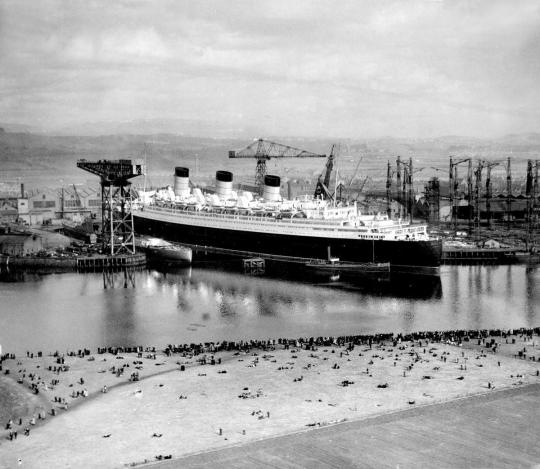
On September 26th 1934 the Liner Queen Mary launched at John Brown’s shipyard, Clydebank.
The construction of still the unnamed Cunard Queen Mary ship began in December 1930 (the ship’s keel was laid down on 31 January 1931) in the yard of “John Brown & Co” at Clydebank. The launch was scheduled for May 1932, but the work on the ship was suspended in December 1931 due to the world economic depression. A loan of 9.5 million pounds from the Government was granted to the Cunard Line with enough money to complete the Queen Mary ship and to build a second liner – the Queen Elizabeth.
As a direct result of this most advantageous deal, the Cunard Line merged with its main rival White Star on 10th May 1934 into Cunard White Star Ltd. The Queen Mary construction resumed in April 1934, the liner was completed by August and launched on 26th September at a total cost of 3.5 million pounds sterling.
The work was completed in March 1936. The Queen Mary ship sailed out for preliminary trials and after being painted in Southampton, the liner was handed over to Cunard White Star Line on 11th May 1936. RMS Queen Mary ship first sailing was on 14th May with its Transatlantic itinerary being Southampton-Cherbourg-New York. By May 1937 the liner had carried a total of almost 57,000 passengers.
The main speed-rival of the QM ship was SS Normandie – a liner built in France and operated by the French Compagnie Generale Transatlantique line. The Queen Mary took the Blue Riband (the prestigious award given to a ship with the speed record for a transatlantic crossing) from the French liner SS Normandie in August 1938, with record speeds for both west- and eastbound crossings of the Atlantic Ocean – the average speeds was, respectively, 30,63 kn (35m25 mph, 56,7 km/h) and 30,14 kn (34,68 mph, 55,82 km/h).
In 1937, the Normandie liner was refitted with new propellers, enabling her to take the Blue Riband, but in 1938 the Queen Mary ship reclaim the honour for best speeds in both directions – westbound 30,99 kn (35,66 mph, 57.39 km/h) and eastbound 31,69 kn (36,47 mph, 58.69 km/h). This record was beaten by the SS United Sates liner in 1952.
The last commercial sailing of the ship Queen Mary was on 30 August 1939 departing from Southampton and then berthed at New York until the end of 1939. With the outbreak of the Second World War, she was converted into a troopship and ferried Allied soldiers for the duration of the war.
Following the war, Queen Mary was refitted for passenger service and along with Queen Elizabeth commenced the two-ship transatlantic passenger service for which the two ships were initially built. The two ships dominated the transatlantic passenger transportation market until the dawn of the jet age in the late 1950s. By the mid-1960s, Queen Mary was ageing and, though still among the most popular transatlantic liners, was operating at a loss.
After several years of decreased profits for Cunard Line, Queen Mary was officially retired from service in 1967. She left Southampton for the last time on 31 October 1967 and sailed to the port of Long Beach, California, United States, where she remains permanently moored. Much of the machinery, including one of the two engine rooms, three of the four propellers, and all of the boilers, were removed. The ship serves as a tourist attraction featuring restaurants, a museum and a hotel. The ship is listed on the National Register of Historic Places. The National Trust for Historic Preservation has accepted the Queen Mary as part of the Historic Hotels of America.
RMS Queen Mary remains in Long Beach but recently it has been reported it is in need of significant repairs according to assessments and photos in 2019 and 2020. An estimated $289 million in repairs are needed after years of decline and the most recent operator going bankrupt.But even to “retire and recycle” the liner could cost up to $190m. One of the suggestions are to dismantle and sink the liner, although no long term plans have been finalised as yet.
The Queen Mary is due to open again to visitors next month, let’s hope someone can come up with a rescue plan to save her.
It has been mooted that it could return to the Clyde but the eyewatering amount of money it would take surely rules this out.
13 notes
·
View notes
Text

Hovsep Pushman (Armenian-American, 1877-1966) • L'Esperance • Unknown date • Oil on board The Woodrow Wilson House, a site of The National Trust for Historic Preservation
#art#painting#fine art#art history#american artist#oil painting#hovsep pushman#artist#women in artworks#portrait#anonymous portrait#female portrait#painter#american painter#art blog#pagan sphinx art blog
6 notes
·
View notes